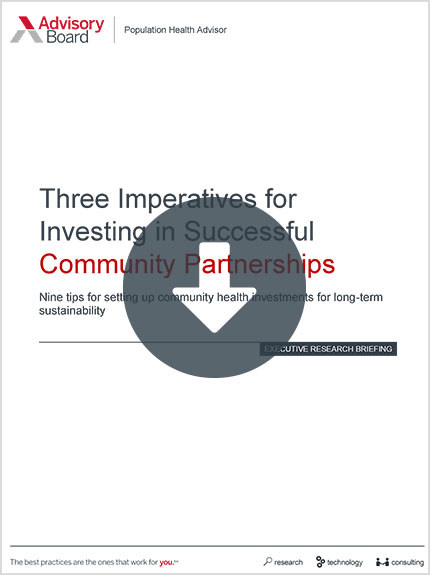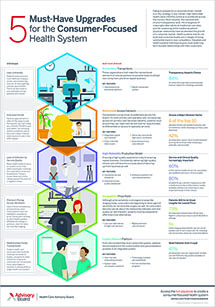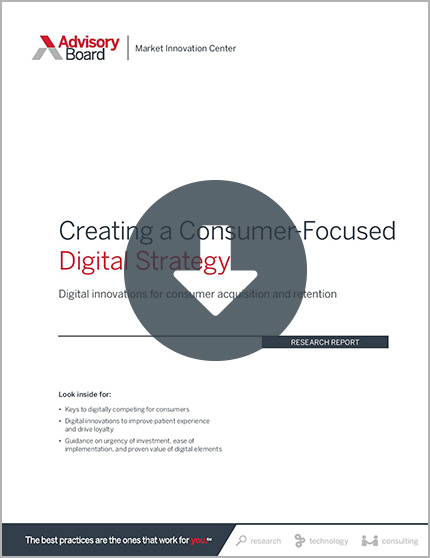By Jackie Kimmell, Senior Analyst
When Lyft filed for its initial public offering (IPO) last month, one fact became increasingly clear: The company is hemorrhaging money. The company reported a net loss of $2.3 billion over the past three years, and it's not sure it can be profitable in the future. "We have a history of net losses and we may not be able to achieve or maintain profitability in the future," the company wrote in the filing document.
Four lessons on reducing no-show rates with hospital-provided transportation
Yet, on Friday, Lyft vastly outperformed expectations when it began public trading. Lyft shares opened up 20% at $87.24—giving it a market value over $26 billion (and making it one of the most valuable American companies to go public in the past decade).
So why were investors (at least initially) so bullish on the company? Because of the future it promises—a big part of which is driverless cars. The company says they want autonomous vehicles to provide most of its trips within the next five years. However, this goal is quite optimistic, as the technology and regulatory environment for self-driving cars may still be years off.
Why Lyft bets big on driverless cars—and how health care could get it there
Right now, Lyft loses money on every ride it facilitates (largely because of the high cost of paying drivers). Self-driving cars, therefore, are a vital way to revise this losing equation. But how can it survive until driverless cars are a reality? It needs to build scale by increasing its rider base—and it's identified the health care industry as a major source of new customers.
The Altarum Institute estimates 3.6 million Americans miss or delay medical appointments each year due to a lack of transportation, and many more rely on medical transport with long-wait times and high rates of driver no-shows. Lyft believes that it can offer patients a better service. Plus, while the most-frequent users of ride-sharing tend to be young, educated, and affluent, those who often lack medical transport are often older, poorer, and more rural—representing a whole new market for the company.
Lyft's goals in health care are robust—no less than, as it said in a blog post, "reimagining the way health care organizations and their patients get around." But how exactly does the company want to implement its vision? Here are three main health care audiences Lyft has been pursuing—and its chances of success moving forward.
3 key audiences for Lyft in the health care market
What's interesting about Lyft's approach to health care is that the company really only has one product to sell: rides to patients to get them from place 'a' to place 'b.' But they've marketed that single product very differently depending on who they're marketing it to.
The provider audience: cut down on missed appointments and patient no-shows
According to oft-cited figures, missed health care appointments cost the U.S. health care system $150 billion per year, and the average clinic can have no-show rates as high as 30%. These no-shows cost an average community hospital an estimated $3 million annually, an average outpatient practice $725 per day, and the typical physician $200 per no-show.
Plus, those with the greatest transportation barriers tend to have the highest burden of chronic disease—meaning that transporting them to appointments is often not just cost-effective but actually cost-saving (i.e., additional investments in transport actually lead to net decrease in total costs).
That's why Lyft (and Uber) have targeted providers touting their ability to help ensure more patients get to their appointments (and on time). The early results of these efforts seem to be mixed leaning positive. In one study, patients given a Lyft ride to two CareMore facilities in California were 18% more punctual and saved the system 39% in transportation costs in the first year and a half. Similarly, a year-long pilot offering Lyft rides to patients at Hennepin Healthcare internal medicine clinics in Minneapolis found a 27% reduction in no-shows. Similar results have been found with Uber; Boston Medical Center reported greater patient satisfaction and $500,000 in transportation savings by using Uber Health.
However, a well-publicized JAMA study, which provided free Lyft rides to Medicaid beneficiaries at two Penn Medicine primary care practices in West Philadelphia, found no difference in the rate of missed appointments compared with those who were just reminded of their appointment—and saw a low overall uptake of the rides. This was one of the few studies to-date that used a control group to compare the ridesharing service to normal appointment reminders (as opposed to implementing a program and seeing how total no-show rates changed).
Regardless, Lyft has been able to make major inroads with providers. The company has already secured partnerships with nine health care systems, including high-profile affiliations with 141-hospital system Ascension and Denver Health. While both of these providers report positive early results, the ROI and true impact of the programs have yet to be seen. Success at reducing no-show rates, for instance, will likely depend on each system's patient population, existing appointment reminder system, and local transit infrastructure.
To learn more on evaluating these partnerships, view our blog post, "Our take: Uber and Lyft want to partner with you. Is that a good investment?"
The payer audience: reduce beneficiary spending—especially for those with Medicare Advantage
Lyft also has partnered with many of the industry's largest health plans to provide transportation to beneficiaries. The company recently announced that it was expanding its collaboration with the Blue Cross Blue Shield Institute to provide rides to Medicare Advantage (MA) members. Since 2017, Lyft has partnered with the Institute to provide transportation access for beneficiaries in "transportation deserts," and in 2018, the company expanded the program to offer round-trip rides to pharmacies for prescription medication pick-up. Now, with the increased MA benefit design flexibility, the company will work with Lyft to provide "rides to-and-from medical appointments, the pharmacy, and fitness centers."
Lyft has similar partnerships with Humana and collaborated on a six-month pilot with Cigna-Health Spring, which offered 14,500 free rides to members with MA (with 92% of members saying they preferred the service). The company also has worked with the University of Southern California, as well as UnitedHealthcare* and the AARP Foundation, to test how providing free unlimited Lyft rides to seniors (for all of their needs, not just to transport to medical appointments) would impact their quality of life. Early results show that 90% said the program had a "positive impact" on their quality of life, 68% said it was easier to travel to medical visits, and 35% got more daily activity (measured by their steps counts).
These health plans seem to be betting that the services can help prevent delays in treatment for their members—which can worsen health outcomes—and prevent unnecessary utilization. And it seems like this is playing out. According to Lyft's 2019 economic impact report, 36% of riders who have used the service to get to medical appointments report that they've gone to urgent care less frequently. Plus, they seem to reduce ambulance usage—another major source of spending for health plans.
And Lyft is on track to ramp up its Medicare Advantage business after it unveiled a web-based Concierge feature, which allows members without smartphones (including more than half of those over age 65) to request rides.
Tech company audience: improve their offerings
Finally, Lyft is offering its services to health care technology companies, most notably partnering with Allscripts to embed a physician ride order feature into Allscript's Sunrise EHR. According to Lyft, the partnership allows them integrate their platform into the routines of 2,500 hospitals and 45,000 physician practices—reaching 180,000 physicians and 7 million patients. "The idea is here simply to give health care providers the ability to call a ride for a patient by pushing a button inside systems they already use," said Lyft's chief business officer David Baga.
For Lyft, this partnership is likely a shrewd business decision as it will reduce the effort necessary for physicians and health care professionals to connect their patients to the rides. It also is likely a win for Allscripts, which can tout the feature against competitors as one that can make doctors' lives easier.
Lyft has also partnered with a number of companies that providers already use to schedule non-emergency transport for patients, like Acuity Link, RoundTrip, Circulation, and Hitch Health. Lyft can often offer cheaper rates than the transport options these companies already use, while Lyft benefits from their existing network of partnerships.
Will Lyft be successful in health care?
Despite the inroads Lyft has made in the industry so far, Megan Callahan, Lyft's VP of health, says that "they are just seeing the beginning of the possibilities [in the industry]." But can the company succeed?
Certainly, we've seen that there are strong incentives for providers (who want to reduce no-shows), payers (that want to reduce spending), and tech companies (that want to provide a better clinical product) to partner with the company. There's also huge latitude to disrupt the nonemergency medical transportation industry, which has been criticized for rising costs, integrity problems, and lack of vendor oversight.
Plus, while, in the past, some patients had expressed discomfort with traveling to appointments in random vehicles—as opposed to with a more official, branded transportation service—familiarity with ride-hailing services has grown dramatically in the past few years. In 2015, 33% of Americans surveyed had never heard of ride-hailing services—which dropped to 3% in 2018. This comfort will likely help with patient ride uptake.
However, like many health care disruptors before, Lyft will face the challenge of working in a highly regulated industry. Uber was recently sued by a San Francisco-based advocacy group for not providing wheelchair-accessible transport—a fate that could also limit, and befall, Lyft.
Another issue is HIPAA compliance. Both Lyft and Uber claim that their platforms are HIPAA-compliant, but because drivers are classified as independent contractors and don't have to undergo HIPAA-training, the companies could face penalties if drivers were to leak the names of patients being driven to appointments or where they're going. Lyft (and Uber) are also uniquely vulnerable to a data breach, given their access to millions of patient names and transportation records. Lyft's IPO filing estimates that a breach would make them vulnerable to approximately $1.5 million in civil penalties.
Lyft could also be limited by the fact that its drivers are not trained in patient care. Uber launched a specialty product, uberASSIST, in which drivers are specially trained to help elderly passengers and those with disabilities, but Lyft has yet to pursue the same approach.
Which brings us to a final fact to remember about Lyft's efforts: Uber is pursing the same strategy. The company launched Uber Health last year and claims partnerships with over 100 health care organizations including MedStar Health, LifeBridge Health, NYU Perlmutter Cancer Center, and Yale New Haven Health. For Lyft to be successful, it will either have to outcompete Uber (which is currently has a much larger share of the market)—or hope that the industry is big enough for both companies to succeed. At least, that is, until the day of autonomous vehicles.
Learn more: How can your organization address transportation barriers?
To learn more about what your hospital or health system can do to address transportation barriers, view our blog posts, "Four lessons on reducing no-show rates with hospital-provided transportation" and "Four ways hospitals can provide transportation assistance to drive access improvements."
Then, learn more about four steps for focusing on the highest return community health needs with our Toolkit for Prioritizing Community Health Interventions.
Don't miss out on the latest Advisory Board insights
Create your free account to access 1 resource, including the latest research and webinars.
Want access without creating an account?
You have 1 free members-only resource remaining this month.
1 free members-only resources remaining
1 free members-only resources remaining
You've reached your limit of free insights
Become a member to access all of Advisory Board's resources, events, and experts
Never miss out on the latest innovative health care content tailored to you.
Benefits include:
You've reached your limit of free insights
Become a member to access all of Advisory Board's resources, events, and experts
Never miss out on the latest innovative health care content tailored to you.
Benefits include:
This content is available through your Curated Research partnership with Advisory Board. Click on ‘view this resource’ to read the full piece
Email ask@advisory.com to learn more
Click on ‘Become a Member’ to learn about the benefits of a Full-Access partnership with Advisory Board
Never miss out on the latest innovative health care content tailored to you.
Benefits Include:
This is for members only. Learn more.
Click on ‘Become a Member’ to learn about the benefits of a Full-Access partnership with Advisory Board
Never miss out on the latest innovative health care content tailored to you.



